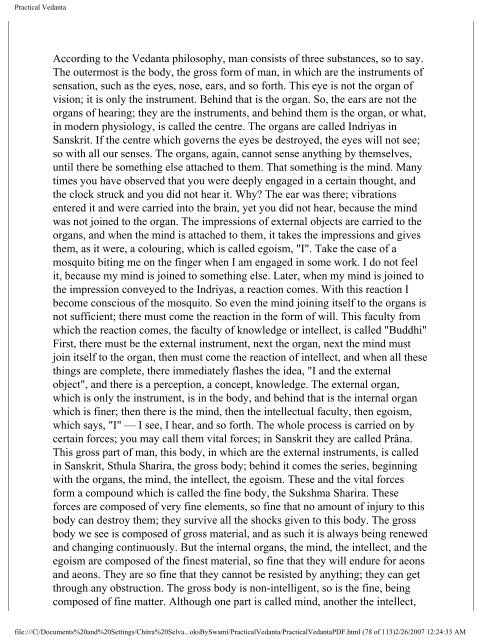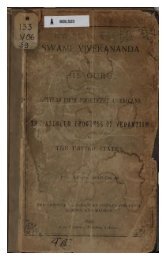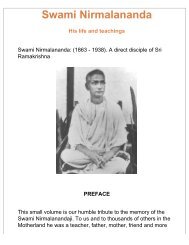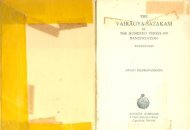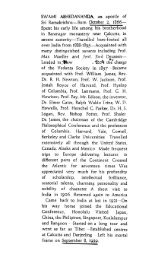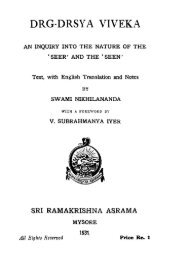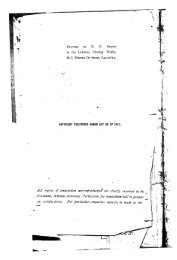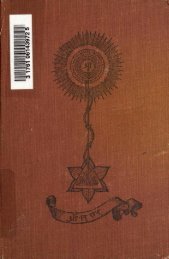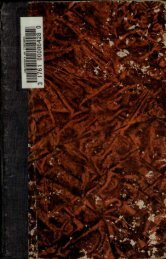<strong>Practical</strong> <strong>Vedanta</strong>According to the <strong>Vedanta</strong> philosophy, man consists of three substances, so to say.The outermost is the body, the gross form of man, in which are the instruments ofsensation, such as the eyes, nose, ears, and so forth. This eye is not the organ ofvision; it is only the instrument. Behind that is the organ. So, the ears are not theorgans of hearing; they are the instruments, and behind them is the organ, or what,in modern physiology, is called the centre. The organs are called Indriyas inSanskrit. If the centre which governs the eyes be destroyed, the eyes will not see;so with all our senses. The organs, again, cannot sense anything by themselves,until there be something else attached to them. That something is the mind. Manytimes you have observed that you were deeply engaged in a certain thought, andthe clock struck and you did not hear it. Why? The ear was there; vibrationsentered it and were carried into the brain, yet you did not hear, because the mindwas not joined to the organ. The impressions of external objects are carried to theorgans, and when the mind is attached to them, it takes the impressions and givesthem, as it were, a colouring, which is called egoism, "I". Take the case of amosquito biting me on the finger when I am engaged in some work. I do not feelit, because my mind is joined to something else. Later, when my mind is joined tothe impression conveyed to the Indriyas, a reaction comes. With this reaction Ibecome conscious of the mosquito. So even the mind joining itself to the organs isnot sufficient; there must come the reaction in the form of will. This faculty fromwhich the reaction comes, the faculty of knowledge or intellect, is called "Buddhi"First, there must be the external instrument, next the organ, next the mind mustjoin itself to the organ, then must come the reaction of intellect, and when all thesethings are complete, there immediately flashes the idea, "I and the externalobject", and there is a perception, a concept, knowledge. The external organ,which is only the instrument, is in the body, and behind that is the internal organwhich is finer; then there is the mind, then the intellectual faculty, then egoism,which says, "I" — I see, I hear, and so forth. The whole process is carried on bycertain forces; you may call them vital forces; in Sanskrit they are called Prâna.This gross part of man, this body, in which are the external instruments, is calledin Sanskrit, Sthula Sharira, the gross body; behind it comes the series, beginningwith the organs, the mind, the intellect, the egoism. These and the vital forcesform a compound which is called the fine body, the Sukshma Sharira. Theseforces are composed of very fine elements, so fine that no amount of injury to thisbody can destroy them; they survive all the shocks given to this body. The grossbody we see is composed of gross material, and as such it is always being renewedand changing continuously. But the internal organs, the mind, the intellect, and theegoism are composed of the finest material, so fine that they will endure for aeonsand aeons. They are so fine that they cannot be resisted by anything; they can getthrough any obstruction. The gross body is non-intelligent, so is the fine, beingcomposed of fine matter. Although one part is called mind, another the intellect,file:///C|/Documents%20and%20Settings/Chitra%20Selva...oksBySwami/<strong>Practical</strong><strong>Vedanta</strong>/<strong>Practical</strong><strong>Vedanta</strong>PDF.html (78 of 113)2/26/2007 12:24:33 AM
<strong>Practical</strong> <strong>Vedanta</strong>and the third egoism, yet we see at a glance that no one of them can be the"Knower". None of them can be the perceiver, the witness, the one for whomaction is made, and who is the seer of the action. All these movements in themind, or the faculty of intellection, or egoism, must be for some one else. Thesebeing composed of fine matter cannot be self-effulgent. Their luminosity cannotbe in themselves. This manifestation of the table, for instance, cannot be due toany material thing. Therefore there must be some one behind them all, who is thereal manifester, the real seer, the real enjoyer and He in Sanskrit is called theAtman, the Soul of man, the real Self of man. He it is who really sees things. Theexternal instruments and the organs catch the impressions and convey them to themind, and the mind to the intellect, and the intellect reflects them as on a mirror,and back of it is the Soul that looks on them and gives His orders and Hisdirections. He is the ruler of all these instruments, the master in the house, theenthroned king in the body. The faculty of egoism, the faculty of intellection, thefaculty of cogitation, the organs, the instruments, the body, all of them obey Hiscommands. It is He who is manifesting all of these. This is the Atman of man.Similarly, we can see that what is in a small part of the universe must also be inthe whole universe. If conformity is the law of the universe, every part of theuniverse must have been built on the same plan as the whole. So we naturallythink that behind the gross material form which we call this universe of ours, theremust be a universe of finer matter, which we call thought, and behind that theremust be a Soul, which makes all this thought possible, which commands, which isthe enthroned king of this universe. That soul which is behind each mind and eachbody is called Pratyagâtman, the individual Atman, and that Soul which is behindthe universe as its guide, ruler, and governor, is God.The next thing to consider is whence all these things come. The answer is: What ismeant by coming? If it means that something can be produced out of nothing, it isimpossible. All this creation, manifestation, cannot be produced out of zero.Nothing can be produced without a cause, and the effect is but the causereproduced. Here is a glass. Suppose we break it to pieces, and pulverise it, and bymeans of chemicals almost annihilate it. Will it go back to zero? Certainly not.The form will break, but the particles of which it is made will be there; they willgo beyond our senses, but they remain, and it is quite possible that out of thesematerials another glass may be made. If this is true in one case, it will be so inevery case. Something cannot be made out of nothing. Nor can something bemade to go back to nothing. It may become finer and finer, and then again grosserand grosser. The raindrop is drawn from the ocean in the form of vapour, anddrifts away through the air to the mountains; there it changes again into water andflows back through hundreds of miles down to the mother ocean. The seedproduces the tree. The tree dies, leaving only the seed. Again it comes up asanother tree, which again ends in the seed, and so on. Look at a bird, how from;the egg it springs, becomes a beautiful bird, lives its life and then dies, leavingonly other eggs, containing germs of future birds. So with the animals; so withfile:///C|/Documents%20and%20Settings/Chitra%20Selva...oksBySwami/<strong>Practical</strong><strong>Vedanta</strong>/<strong>Practical</strong><strong>Vedanta</strong>PDF.html (79 of 113)2/26/2007 12:24:33 AM
- Page 1 and 2:
Practical VedantaPractical VedantaP
- Page 3 and 4:
Practical Vedantaworld. If I am a s
- Page 5 and 6:
Practical Vedantadifference is only
- Page 7 and 8:
Practical VedantaThe ideal of faith
- Page 9 and 10:
Practical Vedantamoment of our live
- Page 11 and 12:
Practical Vedantaof the Christs and
- Page 13 and 14:
Practical Vedanta"This life is Brah
- Page 15 and 16:
Practical Vedantadark fifteen days,
- Page 17 and 18:
Practical Vedantalife. This is the
- Page 19 and 20:
Practical Vedantaeverything would b
- Page 21 and 22:
Practical Vedantait is only through
- Page 23 and 24:
Practical Vedantawhich is that subt
- Page 25 and 26:
Practical Vedantanoumenon and pheno
- Page 27 and 28: Practical Vedantato which is the be
- Page 29 and 30: Practical VedantaAbsolute.The finit
- Page 31 and 32: Practical Vedantawhich is not the q
- Page 33 and 34: Practical Vedantaexperience that th
- Page 35 and 36: Practical Vedantafulfilled. The Jiv
- Page 37 and 38: Practical Vedantabetween the pure r
- Page 39 and 40: Practical Vedantacome out straight.
- Page 41 and 42: Practical Vedantawar with one anoth
- Page 43 and 44: Practical Vedantanobody could under
- Page 45 and 46: Practical VedantaMy idea, therefore
- Page 47 and 48: Practical Vedantathe same methods.
- Page 49 and 50: Practical Vedantavarious minds, all
- Page 51 and 52: Practical Vedantabrotherhood; but t
- Page 53 and 54: Practical Vedantabrotherhood, but w
- Page 55 and 56: Practical Vedantawe all go with ves
- Page 57 and 58: Practical Vedantareason. What can y
- Page 59 and 60: Practical Vedantabeen preached in t
- Page 61 and 62: Practical Vedantathe husband kisses
- Page 63 and 64: Practical Vedantaof the knowledge a
- Page 65 and 66: Practical Vedantafor those who only
- Page 67 and 68: Practical Vedantasun exists because
- Page 69 and 70: Practical Vedantaof death was pleas
- Page 71 and 72: Practical VedantaGod. We must learn
- Page 73 and 74: Practical Vedantaa plague comes, it
- Page 75 and 76: Practical VedantaAtman? "As with a
- Page 77: Practical Vedantathat immortal One,
- Page 81 and 82: Practical VedantaWitness of the uni
- Page 83 and 84: Practical VedantaPractical Vedanta1
- Page 85 and 86: Practical Vedantaeternal ; every ot
- Page 87 and 88: Practical Vedantafaculty, Buddhi, w
- Page 89 and 90: Practical VedantaPractical Vedanta1
- Page 91 and 92: Practical Vedantastepping-stone to
- Page 93 and 94: Practical Vedantarecognition? Findi
- Page 95 and 96: Practical Vedantasentient." This is
- Page 97 and 98: Practical Vedantaessentially differ
- Page 99 and 100: Practical Vedantaexistence is limit
- Page 101 and 102: Practical Vedantalive, for I am lif
- Page 103 and 104: Practical Vedantasee from Kapila's
- Page 105 and 106: Practical Vedantalimitation, but th
- Page 107 and 108: Practical Vedantaperfect, infinite,
- Page 109 and 110: Practical Vedantaindividuality, of
- Page 111 and 112: Practical Vedantarepeat [something]
- Page 113: Practical Vedantaperson who dies in


